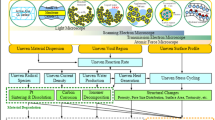Abstract
Micro flow channels in flow plates of fuel cells have become much narrower and longer to improve reactant flow distribution leading to increase of pumping power. Therefore it is very important to minimize the pressure drops in the flow channel because increased pumping power reduces overall efficiency. We investigated pressure drops in a micro flow channel at the anode and cathode compared to pressure losses for cold flow in straight, bended and serpentine channels. The results show that friction factors for cold flow channels could be used for parallel and bended flow channel designs for fuel cells. Pressure drop in the serpentine flow channel is the lowest among all flow channels due to bypass flow across the gas diffusion layer under reactive flow condition, although its pressure drop is highest for a cold flow condition. So the effect of bypass flow for serpentine flow channels should be considered when designing flow channels
Similar content being viewed by others
References
J. A. C. Humphrey, J. H. Whitelaw and G. Yee, Turbulent Flow in a Square Duct with Strong Curvature, J. Fluid Mech. 103 (1981) 443–463.
Y. Miyaka, T. Kazishima and T. Inaba, International Conference on Experimental Heat Transfer, Fluid Mechanics and Thermodynamics, (1988).
A. J. Ward-Smith, Internal Fluid Flow, Oxford university press, New York, USA (1980).
S. Maharudrayya, S. Jayanti and A. P. Deshpande, Pressure losses in laminar flow through serpentine channels in fuel cell stacks, J. Power Sources 138 (2004) 1–13.
L. Sun, P. H. Oosthuizen, B. Kim and McAuley, A numerical study of channel-to-channel flow crossover through the gas diffusion layer in a PEM-fuel-cell flow system using a serpentine channel with a trapez-oidal cross-sectional shape, Int. J. Thermal Sciences 45 (2006) 1021–1026.
J. Yuan, M. Rokni and B. Sunden, A numerical investigation of gas flow and heat transfer in proton exchange membrane fuel cells, Num. Heat Transfer (partA) 44 (2003) 255–280.
A. S. Rawool, S. K. Mitra and J. G. Pharoah, An investigation of convective transport in micro proton-exchange membrane fuel cells, J. Power Source 162 (2006) 985–991.
A. S. Rawool, S. K. Mitra, A. Agrawal and S. Kandikar, Numerical simulation of flow through microchannels in bipolar plate, ICMM (2005) 2005-75251.
J. G. Pharoah, On the permeability of gas diffusion media used in PEM fuel cells, J. Power sources 144 (2005) 77–82.
R. B. Bird, W. E. Stewart and E. N. Lightfoot, Transport phenomena, Wiley, New York, UAS, (1960).
Author information
Authors and Affiliations
Corresponding author
Rights and permissions
About this article
Cite this article
Cho, SA., Lee, PH., Han, SS. et al. Pressure data for various flow channels in proton exchange membrane (PEM) fuel cell. J Mech Sci Technol 22, 583–589 (2008). https://doi.org/10.1007/s12206-007-1108-4
Received:
Revised:
Accepted:
Published:
Issue Date:
DOI: https://doi.org/10.1007/s12206-007-1108-4




